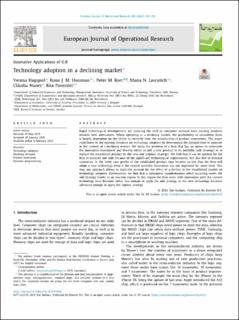| dc.contributor.author | Hagspiel, Verena | |
| dc.contributor.author | Huisman, Kuno J.M. | |
| dc.contributor.author | Kort, Peter M. | |
| dc.contributor.author | Lavrutich, Maria | |
| dc.contributor.author | Nunes, Cláudia | |
| dc.contributor.author | Pimentel, Rita | |
| dc.date.accessioned | 2021-02-24T13:48:03Z | |
| dc.date.available | 2021-02-24T13:48:03Z | |
| dc.date.created | 2020-02-07T12:12:09Z | |
| dc.date.issued | 2020 | |
| dc.identifier.citation | European Journal of Operational Research. 2020, 285 (1), 380-392. | en_US |
| dc.identifier.issn | 0377-2217 | |
| dc.identifier.uri | https://hdl.handle.net/11250/2730169 | |
| dc.description.abstract | Rapid technological developments are inducing the shift in consumer demand from existing products towards new alternatives. When operating in a declining market, the profitability of incumbent firms is largely dependent on the ability to correctly time the introduction of product innovations. This paper contributes to the existing literature on technology adoption by determining the optimal time to innovate in the context of a declining market. We study the problem of a firm that has an option to undertake the innovation investment and thereby either to add a new product to its portfolio (add strategy) or to replace the established product by the new one (replace strategy). We find that it can be optimal for the firm to innovate not only because of the significant technological improvement, but also due to demand saturation. In the latter case profits of the established product may become so low that the firm will adopt a new technology even if the newest available innovation has not improved for some time. This way, our approach allows to explicitly account for the effect of a decline in the established market on technology adoption. Furthermore, we find that a substantial cannibalization effect occurring under the add strategy results in an inaction region. In this region the firm waits with innovation until the current technology level becomes either low enough to apply the add strategy, or the new technology becomes advanced enough to apply the replace strategy. | en_US |
| dc.language.iso | eng | en_US |
| dc.publisher | Elsevier | en_US |
| dc.rights | Navngivelse 4.0 Internasjonal | * |
| dc.rights.uri | http://creativecommons.org/licenses/by/4.0/deed.no | * |
| dc.title | Technology adoption in a declining market | en_US |
| dc.type | Peer reviewed | en_US |
| dc.type | Journal article | en_US |
| dc.description.version | publishedVersion | en_US |
| dc.source.pagenumber | 380-392 | en_US |
| dc.source.volume | 285 | en_US |
| dc.source.journal | European Journal of Operational Research | en_US |
| dc.source.issue | 1 | en_US |
| dc.identifier.doi | 10.1016/j.ejor.2020.01.056 | |
| dc.identifier.cristin | 1791964 | |
| dc.description.localcode | © 2020 The Authors. Published by Elsevier B.V. This is an open access article under the CC BY license. (http://creativecommons.org/licenses/by/4.0/) | en_US |
| cristin.ispublished | true | |
| cristin.fulltext | postprint | |
| cristin.fulltext | original | |
| cristin.qualitycode | 2 | |

